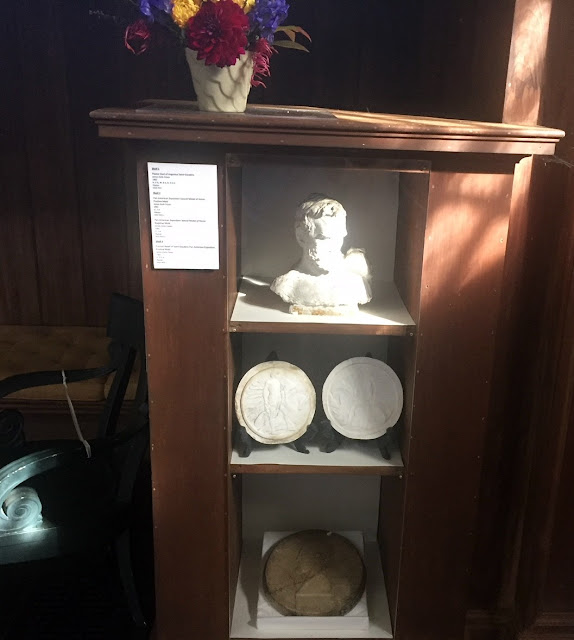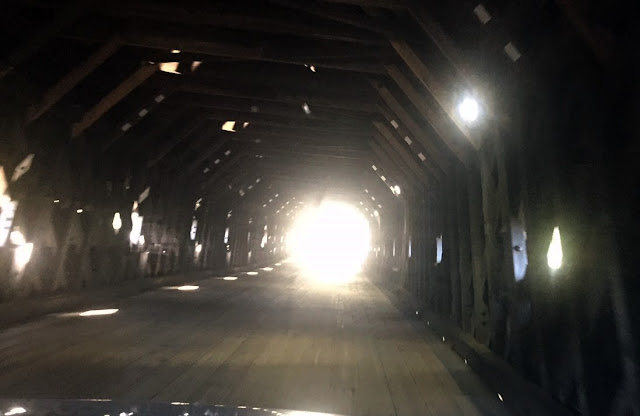We visited freinds of ours in Vermont this past weekend. Saturday we went for hike in the mountains around their home, followed by some delicious pomegranate-sage Margaritas at The Woodstock Inn, and dinner at another eatery in an old Vermont Inn. Sunday morning we headed across the Connecticut River and then North a short way into Cornish, New Hampshire to visit the Saint-Gaudens National Historic site.
 Heading South along the Connecticut River towards the covered bridge linking Cornish, New Hampshire and Windsor, Vermont. It is the longest covered bridge in New England.
Heading South along the Connecticut River towards the covered bridge linking Cornish, New Hampshire and Windsor, Vermont. It is the longest covered bridge in New England.
Augustus Saint-Gaudens was born in Dublin to a French father and an Irish mother; the family moved to New York City before August was 1 year old. He started his career apprenticed to a cameo artist, and later later studied art and architecture in Paris and Rome. His first major commission was the Admiral David Farragut monument (above), unveiled in New York City in 1881; the bronze statue was highly realistic, while the bluestone base was allegorical. It was very well received, and before long Saint-Gaudens became the preeminent sculptor in the United States.
Standing Lincoln, 1887; the original is in Lincoln Park in Chicago, with replicas in London, at Lincoln's tomb in Springfield, Illinois, Mexico City, and here in Cornish (the later cast just in 2016; it is over 12 feet tall.
Perhaps the most impressive of Saint-Gauden's works is the Robert Gould Shaw Memorial, 1887; he worked on it for 14 years. The original sits on Boston Commons,
Colonel Shaw lead the 54th Massachussetts, the first US colored regiment. He was killed in action leading the assault on Fort Wagner, July 17, 1863. The story of Shaw and the 54th are told in the movie Glory.
11 feet tall by 14 feet wide (and about 3 feet deep), it is most impressive and evocative.
One can only imagine the skill involved in not only conceiving and sculpting it, but in casting it as well!
The Adams Memorial; commissioned by Henry Adams for his wife's grave site; Saint-Gaudens himself called it The Mystery of the Hereafter and The Peace of God that Passeth Understanding.
Fall Gardens, with Mount Ascutney (Vermont) in the distance.
Fountain and probably a pond for Koi, alongside the artist's New Studio; the veranda of his estate, Aspet, is in the background.
Plaster casts from the friezes at the Parthenon adorn the tops of the exterior walls of the studio.
Columns and grape arbor on the porch of the studio.
Saint-Gaudens was particularly famous for his bas-relief sculptures and casts thereof.
He also designed several US coins, including the $20 gold double-eagle coin.
A reduced size statue of Dianna; the original was gilded, 13 feet tall, and was situated atop the tower of Madison Square Garden in new York City until 1925; several versions were created..
Deep bas-relief bronze of Louise Howland (1884).
Plaster studies for one of Saint-Gauden's projects.
More plaster masters.
Plaster model of a copmmisioned mantel design.
Steps involved in the creation of the monument to William Tecumseh Sherman, which is situated in Grand Army Plaza in Manhattan.
Detail;s of work on the head of Sherman's horse.
Other works of Saint-Gaudens in the plaster room of his studio.
Model for an obelisk design.
Reduced sized sculpture of Victory, from the Sherman Monument.
Looking from the veranda of Aspet, the artist's home, with Mount Ascutney again in the distance.
View from the veranda looking Northeast. Rotating displays of contemporary sculpture are displayed on the lwan here.
View of the front of Aspet; the locust was planted circa 1900, and has overgrown the stairway!
Saint-Gaudens "New Studio", as seen from the veranda at Aspet.
"The Temple; a marble memorial marking the ashes of Saint-Gaudet and members of his family.
It has been a warm wet Fall, which has dulled the often spectacular fall colors of New England, but I thought the golden leaves of these beeches were striking against the deep blue sky.
 Heading South along the Connecticut River towards the covered bridge linking Cornish, New Hampshire and Windsor, Vermont. It is the longest covered bridge in New England.
Heading South along the Connecticut River towards the covered bridge linking Cornish, New Hampshire and Windsor, Vermont. It is the longest covered bridge in New England.
Fortunately, we left our horses behind!
Crossing the river towards Vermont.
View from our friend's home in Brownsville, Vermont, looking to the Northeast...
and to the Southeast, with Mount Ascutney dominating the skyline.
Heading down the (steep!) driveway for a hike in the mountains, with three dogs and two donkeys along for the fresh air; Tom (in the distance) leads the donkeys; wearing a green outfit; I told him he looked like he was auditioning to play Shrek!
A final view of Mount Ascutney; the ski area there closed several years ago, but the state park remains.



































A lovely part of the world and a fascinating insight into Saint-Gauden. It put me in mind of the Norman Lindsay gallery in the Blue Mountains of New South Wales for some reason.
ReplyDeleteThanks, Laurence; New Zealand is on our "someday to visit" list!
DeleteThe St. Gaudens Historic site is a relatively unknown gem: a must see if anyone is in the area (as this report shows).
ReplyDeleteIndeed; it is open from late May until late October (in other words, when the snow isn't on the grounds!).
DeleteWonderful images of great artwork and landscapes!
ReplyDeleteGlad you enjoyed them, Dean!
DeleteLovely sculptures, artist's studios are always nice places to visit, the scenery is particularly nice for this one!
ReplyDeleteBest Iain
The subject of sculpture is of course germane to our hobby as well!
DeleteRather Romanesque
ReplyDeleteIndeed; classical references were very popular at that time - indeed, what is more Roman than August? His wife was even named Augusta!
DeleteTh classical influence is very clear, and of course he studied in Paris and Rome!
Somehow, I missed your fall Saint-Gaudens' travelogue. Shame on me!
ReplyDeleteInviting New England, Fall landscapes and an interesting tour of Saint-Gaudens' site. I have visited the 54th Mass memorial in Boston (impressive!) and the reproduction in the National Art Museum in D.C. Very inspiring work in both locations.
Thanks for stopping back, Jon. Our friend's home in Vermont is amazing; all tongue in groove construction, with spectacular views to the East of Mt Ascutney and the White Mountains of New Hampshire.
Delete